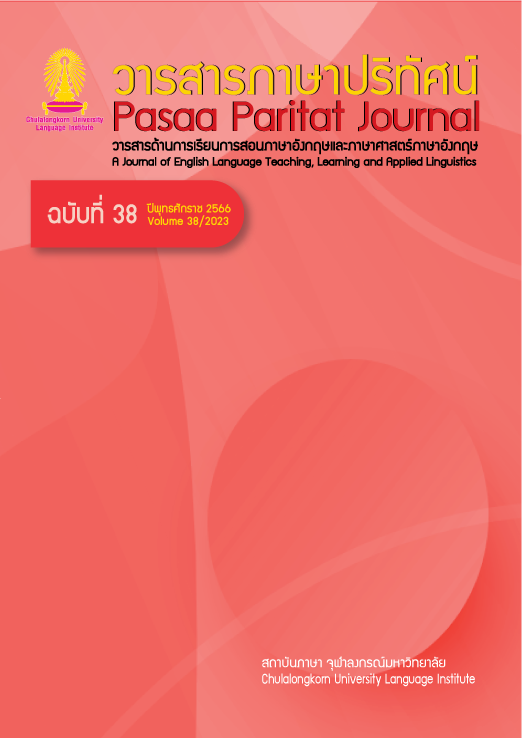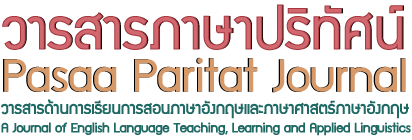เจตคติของนักเรียนที่มีต่อข้อเสนอแนะที่เป็นลายลักษณ์อักษรของครู กรณีศึกษาโรงเรียนอาชีวศึกษาจีนระดับมัธยมศึกษา
DOI:
https://doi.org/10.58837/CHULA.PPJ.38.7คำสำคัญ:
เจตคติของผู้เรียน, การให้ข้อมูลป้อนกลับในการเขียนของครู, ผู้เรียนชาวจีนที่เรียนภาษาอังกฤษเป็นภาษาต่างประเทศบทคัดย่อ
งานวิจัยนี้มีวัตถุประสงค์เพื่อ 1) สำรวจเจตคติผู้เรียนชาวจีนที่เรียนภาษาอังกฤษเป็นภาษาต่างประเทศ เกี่ยวข้องกับการให้ข้อมูลป้อนกลับในการเขียนของครู 2) ตรวจสอบรูปแบบการให้ข้อมูลป้อนกลับในการเขียน ของครูที่ผู้เรียนเชื่อว่าจะเกิดประโยชน์สูงสุดที่จะช่วยให้ผู้เรียนพัฒนาการเขียนได้ การวิจัยดำเนินการโดยใช้ การวิจัยผสมรูปแบบ โดยรวมการวิจัยเชิงปริมาณด้วยการสำรวจ และการวิจัยเชิงคุณภาพด้วยการสัมภาษณ์ โดยดำเนินการกับกรณีศึกษาที่เป็นโรงเรียนอาชีวศึกษาแห่งหนึ่งในจังหวัดกวงดง สาธารณรัฐประชาชนจีน การศึกษานี้เก็บข้อมูลจากผู้ตอบแบบสอบถามจำนวน 200 คน และผู้เรียนที่สมัครใจในการเข้าร่วมการ สัมภาษณ์แบบกึ่งโครงสร้างจำนวน 8 คน ผลจากการวิเคราะห์ข้อมูลแบบสอบถามพบว่า ผู้เรียนมีเจตคติเชิง บวกต่อการให้ข้อมูลป้อนกลับในการเขียนของครู (ค่าเฉลี่ย = 4.40/ค่าเบี่ยงเบนมาตรฐาน = 0.72) และ ความพอใจในประโยชน์ที่ได้จากการให้ข้อมูลป้อนกลับในการเขียนของครูอยู่ในระดับสูง (ค่าเฉลี่ย = 4.43/ค่าเบี่ยงเบนมาตรฐาน = 0.71) นอกจากนี้ยังพบอีกว่า ผู้เรียนเชื่อว่าการให้ข้อมูลป้อนกลับในการเขียน เชิงบวกของครูเป็นประโยชน์ในการช่วยพัฒนาการเขียนของเขา (ค่าเฉลี่ย = 4.52/ค่าเบี่ยงเบนมาตรฐาน = 0.72) ผลจากการสัมภาษณ์ผู้เรียนพบว่าผู้เรียนชอบการให้ข้อมูลป้อนกลับเชิงบวกและคาดหวังว่าจะได้รับการให้ข้อมูล ป้อนกลับในการเขียนของครูเพิ่มขึ้น ในบทความนี้จะมีการอภิปรายเพิ่มเติมถึงข้อเสนอแนะในการนำผลการวิจัยไปใช้
เอกสารอ้างอิง
Alvira, R. (2016). The impact of oral and written feedback of EFL writers with the use of Screencasts. PROFILE issues in Teachers’ Professional Development, 18(2), 79-92. https://doi.org/10.15446/profile.v18n2.53397
Belcher, D., & Liu, J. (2004). Conceptualizing discourse/responding to text. Journal of Second Language Writing, 13(1), 3–6. https://doi.org/10.1016/j.jslw.2004.04.002
Bonsu, E. (2021). The Influence of Written Feedback on the Writing Skill Performance of High School Students. International Journal of Applied Research in Social Sciences, 3(3), 33–43. https://doi.org/10.51594/ijarss.v3i3.234
Brown, G. T. L., Kennedy, K. J., Fok, P. K., Chan, J. K. S., & Yu, W. M. (2009). Assessment for student improvement: understanding Hong Kong teachers’ conceptions and practices of assessment. Assessment in Education: Principles, Policy & Practice, 16(3), 347–363. https://doi.org/10.1080/09695940903319737
Cahyani, N., & Murtafi’ah, B. (2022). Undergraduate students’ perceptions of teachers’ written feedback in academic writing class: A survey study. Communications in Humanities and Social Sciences, 2(2), 60–64. https://doi.org/10.21924/chss.2.2.2022.35
Cohen, A. D., & Cavalcanti, M. C. (1987). Giving and getting feedback on composition: A comparison of teacher and student verbal report. Evaluation & Research in Education, 1(2), 63–73. https://doi.org/10.1080/09500798709533221
Chandler, J. (2003). The efficacy of various kinds of error feedback for improvement in the accuracy and fluency of L2 student writing. Journal of Second Language Writing, 12(3), 267–296. https://doi.org/10.1016/s1060-3743(03)00038-9
Chen, S., Nassaji, H., & Liu, Q. (2016). EFL Learners’ Perceptions and Preferences of Written Corrective Feedback: A Case Study of University Students from Mainland China. Asian-Pacific Journal of Second and Foreign Language Education, 1(1). 1-17. https://doi.org/10.1186/s40862-016-0010-y
Chiang, K. (2004). An investigation into students’ preferences for and responses to teacher feedback and its implications for writing teachers. Hong Kong. Teachers’ Centre Journal, 3(1). 98-115. https://bibliography.lib.eduhk.hk/tc/bibs/c4cd2800
Chong, S. W. (2019). A Systematic Review of Written Corrective Feedback Research in ESL/EFL Contexts. Language Education & Assessment, 2(2), 70-95. https://doi.org/10.29140/lea.v2n2.138
Daiker, D. A. (2011). Learning to praise. Concepts in Composition: Theory and Practice in the Teaching of Writing, 168-174.
Diab, R. L. (2005). EFL university students’ preferences for error correction and teacher feedback on writing. TESL Reporter, 38(1). 27-51. http://hdl.handle.net/10725/2796
Dowden, T., Pittaway, S., Yost, H., & McCarthy, R. (2013). Students’ perceptions of written feedback in teacher education: ideally feedback is a continuing two-way communication that encourages progress. Assessment & Evaluation in Higher Education, 38(3), 349–362. https://doi.org/10.1080/02602938.2011.632676
Ellis, R. (2009). A typology of written corrective feedback types. ELT Journal, 63(2), 97–107. https://doi.org/10.1093/elt/ccn023
Ene, E., & Upton, T. A. (2014). Learner uptake of teacher electronic feedback in ESL composition. System, 46, 80–95. https://doi.org/10.1016/j.system.2014.07.011
Enginarlar, H. (1993). Student response to teacher feedback in EFL writing. System, 21(2), 193–204. https://doi.org/10.1016/0346-251x(93)90041-e
Ferris, D. R. (1995). Student Reactions to Teacher Response in Multiple-Draft Composition Classrooms. TESOL Quarterly, 29(1), 33-53. https://doi.org/10.2307/3587804
Ferris, D. R. (1997). The Influence of Teacher Commentary on Student Revision. TESOL Quarterly, 31(2), 315-339. https://doi.org/10.2307/3588049
Ferris, D. R., & Roberts, B. (2001). Error feedback in L2 writing classes. Journal of Second Language Writing, 10(3), 161–184. https://doi.org/10.1016/s1060-3743(01)00039-x
Ferris, D. R. (2002). Treatment of error in second language writing classes. University of Michigan Press
Ferris, D. R. (2003). Response to student writing: Implications for second language students. Routledge.
Ferris, D. R. (2010). Second language writing research and written corrective feedback in SLA: Intersections and practical applications. Studies in Second Language Acquisition, 32(2), 181-201. https://doi.org/10.1017/s0272263109990490
Ferris, D. R., & Hedgcock, J. S. (2023). Teaching L2 composition: Purpose, process, and practice. Routledge.
Fithriani, R. (2017). Indonesian students' perceptions of written feedback in second language writing (Doctoral dissertation, The University of New Mexico). https://www.proquest.com/dissertations-theses/indonesian-students-perceptions-written-feedback/docview/2029363138/se-2
Furneaux, C., Paran, A., & Fairfax, B. (2007). Teacher stance as reflected in feedback on student writing: An empirical study of secondary school teachers in five countries. IRAL - International Review of Applied Linguistics in Language Teaching, 45(1). 69-94. https://doi.org/10.1515/iral.2007.003
Gee, T. C. (1972). Students’ Responses to Teacher Comments. Research in the Teaching of English, 6(2), 212–221. http://www.jstor.org/stable/40170807
Goldstein, L. M. (2004). Questions and answers about teacher written commentary and student revision: teachers and students working together. Journal of Second Language Writing, 13(1), 63–80. https://doi.org/10.1016/j.jslw.2004.04.006
Grami, M. A. (2005). The Effect of teachers’ written feedback on ESL students’ writing: A Study on a Saudi ESL University-Level Context. Language Teaching, 2. 9-22.
Han, Y. (2017). Mediating and being mediated: Learner beliefs and learner engagement with written corrective feedback. System, 69, 133-142. https://doi.org/10.1016/j.system.2017.07.003
Harris, L. R., Brown, G. T. L., & Harnett, J. A. (2014). Understanding classroom feedback practices: A study of New Zealand student experiences, perceptions, and emotional responses. Educational Assessment, Evaluation and Accountability, 26(2), 107–133. https://doi.org/10.1007/s11092-013-9187-5
Havnes, A., Smith, K., Dysthe, O., & Ludvigsen, K. (2012). Formative assessment and feedback: Making learning visible. Studies in Educational Evaluation, 38(1), 21–27. https://doi.org/10.1016/j.stueduc.2012.04.001
Hedgcock, J., & Lefkowitz, N. (1994). Feedback on feedback: Assessing learner receptivity to teacher response in L2 composing. Journal of Second Language Writing, 3(2), 141–163. https://doi.org/10.1016/1060-3743(94)90012-4
Horwitz, E. K. (1995). Student affective reactions and the teaching and learning of foreign languages. International Journal of Educational Research, 23(7), 573-579. https://doi.org/10.1016/0883-0355(96)80437-X
Huang, S. C. (2016). No Longer a Teacher Monologue--Involving EFL Writing Learners in Teachers' Assessment and Feedback Processes. Taiwan Journal of TESOL, 13(1), 1-31. http://tjtesol.nccu.edu.tw
Hyland, F. (1998). The impact of teacher written feedback on individual writers. Journal of Second Language Writing, 7(3), 255–286. https://doi.org/10.1016/s1060-3743(98)90017-0
Hyland, F. (2000). ESL writers and feedback: giving more autonomy to students. Language Teaching Research, 4(1), 33–54. https://doi.org/10.1177/136216880000400103
Hyland, F., & Hyland, K. (2001). Sugaring the pill: Praise and criticism in written feedback. Journal of second language writing, 10(3), 185-212. https://doi.org/10.1016/s1060-3743(01)00038-8
Hyland, K. (2013). Faculty feedback: Perceptions and practices in L2 disciplinary writing. Journal of Second Language Writing, 22(3), 240–253. https://doi.org/10.1016/j.jslw.2013.03.003
Jamalinesari, A., Rahimi, F., Gowhary, H., & Azizifar, A. (2015). The effects of teacher-written direct vs. indirect feedback on students’ writing. Procedia-Social and Behavioral Sciences, 192, 116-123. https://doi.org/10.1016/j.sbspro.2015.06.018
Lee, I. (2005). Error Correction in the L2 Writing Classroom: What Do Students Think? TESL Canada Journal, 22(2), 1–16. https://doi.org/10.18806/tesl.v22i2.84
Lee, I. (2008). Understanding teachers’ written feedback practices in Hong Kong secondary classrooms. Journal of Second Language Writing, 17(2), 69–85. https://doi.org/10.1016/j.jslw.2007.10.001
Lee, I. (2011). Working Smarter, Not Working Harder: Revisiting Teacher Feedback in the L2 Writing Classroom. Canadian Modern Language Review, 67(3), 377–399. https://doi.org/10.3138/cmlr.67.3.377
Lee, S. M. (2019). The impact of using machine translation on EFL students’ writing. Computer Assisted Language Learning, 33(3), 157–175. https://doi.org/10.1080/09588221.2018.1553186
Leaph, K. (2011). Using oral and written feedback to improve student writing: An Investigation from Cambodian University Students’ Perspectives. Asian EFL Journal,1738-1460. https://www.asian-efl-journal.com/thesis/using-oral-and-written-feedback-to-improve-student-writing-an-investigation-from-cambodian-university-students-perspectives/index.htm
Listiani, L. (2017). Students' perception toward teacher's written corrective feedback in writing 3 class. 4th AECon proceeding. https://doi.org/10.2991/aecon-17.2017.30
Magno, C. & Amarles, A. M. (2011). Teachers’ Feedback Practices in Second language Academic Writing Classrooms. The International Journal of Education and Psychological Assessment, January, 6(2). https://ssrn.com/abstract=2287181
Mahfoodh, O. H. A., & Pandian, A. (2011). A Qualitative Case Study of EFL Students’ Affective Reactions to and Perceptions of Their Teachers’ Written Feedback. English Language Teaching; 4(3),14-25. https://doi.org/10.5539/elt.v4n3p14
Mahfoodh, O. H. A. (2017). “I feel disappointed”: EFL university students’ emotional responses towards teacher written feedback. Assessing Writing, 31(53), 53–72. https://doi.org/10.1016/j.asw.2016.07.001
McMartin-Miller, C. (2014). How much feedback is enough? Instructor practices and student attitudes toward error treatment in second language writing. Assessing Writing,19, 24–35. https://doi.org/10.1016/j.asw.2013.11.003
Ouahidi, M., & Lamkhanter, F. (2020). Students’ perceptions about teachers’ written feedback on writing in a Moroccan university context. Feedback in L2 English Writing in the Arab World: Inside the Black Box, 35-63. https://doi.org/10.1007/978-3-030-25830-6_2
Parr, J. M., & Timperley, H. S. (2010). Feedback to writing, assessment for teaching and learning and student progress. Assessing Writing, 15(2), 68–85. https://doi.org/10.1016/j.asw.2010.05.004
Radecki, P. M., & Swales, J. M. (1988). ESL student reaction to written comments on their written work. System, 16(3), 355–365. https://doi.org/10.1016/0346-251x(88)90078-4
Robinson, S., Pope, D., & Holyoak, L. (2013). Can we meet their expectations? Experiences and perceptions of feedback in first year undergraduate students. Assessment & Evaluation in Higher Education, 38(3), 260–272. https://doi.org/10.1080/02602938.2011.629291
Ruegg, R. (2015). The relative effects of peer and teacher feedback on improvement in EFL students’ writing ability. Linguistics and Education, 29, 73-82. https://doi.org/10.1016/j.linged.2014.12.001
Saidon, M. A., Said, N. E. M., Soh, T. M. T., & Husnin, H. (2018). ESL Students’ Perception of Teacher’s Written Feedback Practice in Malaysian Classrooms. Creative Education, 9(14), 2300–2310. https://doi.org/10.4236/ce.2018.914170
Saragih, N, A., Saragih, W., Madya, S., & Siregar, R.A. (2021). Written corrective feedback: students’ perception and preferences. International Online Journal of Education and Teaching, 8(2). 676-690. https://iojet.org/index.php/IOJET/article/view/1143
Silva, T., & Matsuda, P. K. (2000). On second language writing. Routledge. https://doi.org/10.4324/9781410600899
Tsai, S. C. (2020). Chinese students’ perceptions of using Google Translate as a translingual CALL tool in EFL writing. Computer Assisted Language Learning, 35(5-6), 1250-1272. https://doi.org/10.1080/09588221.2020.1799412
Värlander, S. (2008). The role of students’ emotions in formal feedback situations. Teaching in Higher Education, 13(2), 145–156. https://doi.org/10.1080/13562510801923195
Wang, H. (2012). An Empirical Application of ANOVA, Correlation and Regression Method in English Testing. Intelligent Computing Theories and Applications. https://doi.org/10.1007/978-3-642-31576-3_30
Yang, M., Badger, R., & Yu, Z. (2006). A comparative study of peer and teacher feedback in a Chinese EFL writing class. Journal of Second Language Writing, 15(3), 179–200. https://doi.org/10.1016/j.jslw.2006.09.004
Zacharias, N. T. (2007). Teacher and Student Attitudes toward Teacher Feedback. RELC Journal, 38(1), 38–52. https://doi.org/10.1177/0033688206076157
Zhang, S. (1995). Reexamining the affective advantage of peer feedback in the ESL writing class. Journal of Second Language Writing, 4(3), 209–222. https://doi.org/10.1016/1060-3743(95)90010-1
ดาวน์โหลด
เผยแพร่แล้ว
รูปแบบการอ้างอิง
ฉบับ
ประเภทบทความ
สัญญาอนุญาต
ลิขสิทธิ์ (c) 2023 วารสารภาษาปริทัศน์

อนุญาตภายใต้เงื่อนไข Creative Commons Attribution-NonCommercial-NoDerivatives 4.0 International License.



